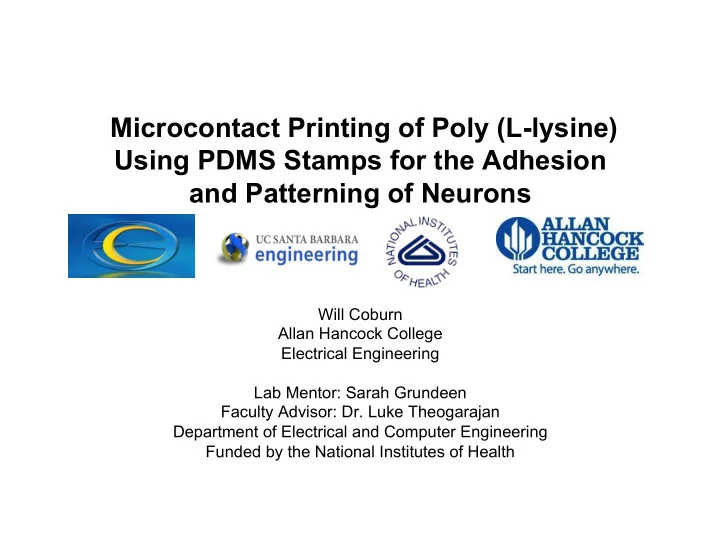

Microcontact Printing of Poly (L-lysine) Using PDMS Stamps for the Adhesion and Patterning of Neurons Will Coburn Allan Hancock College Electrical Engineering Lab Mentor: Sarah Grundeen Faculty Advisor: Dr. Luke Theogarajan Department of Electrical and Computer Engineering Funded by the National Institutes of Health
Neurological Disorders The World Health Organization (WHO, 2007): -One billion people suffer from some form of ND -Europe spent $194 million in 2004 alone on palliative care -Effective care is largely unavailable to many suffering with NDs
-Billions of brain cells = neural network (1 neuron ~ 10 µ m wide) -Send and receive info via electrochemical signals -Neurons comprise who we are .
Research goals for this summer include: Create a novel, reproducible method of Incubate neurons and record patterning healthy rat neurons onto neurite growth glass substrates and multi electrode arrays (MEAs)
Experimentation Polydimethylsiloxane (PDMS) Stamp 15 µ m Force “Ink” = Poly (L-lysine) (PLL), a positive, hydrophilic polymer to promote neuron adherence
Experimental Problems Pillar deformation when non-uniform or excessive force applied to stamp
Experimental Solutions Young’s Modulus (PDMS) ~ 500 kPa Young’s Modulus (Glass) ~ 50 GPa Glass is stiffer than PDMS. Glass-backed stamp provides more even distribution of force, which may lead to less deformation.
Neuronal Plating After PDMS stamping... … stamped substrates were placed in wells and neurons were introduced with media. 2 ml of media mixed with 100,000 rat hippocampal neurons per well 100 µ m
Following Neurite Growth 25 µ m pitch 35 µ m pitch -Large overgrowth areas -PLL absent areas -Non-uniform distribution of force causing stamp deformation Unmodified PDMS Stamp 9 DIV, force of finger, 0.5 mg/ml PLL
Neurite Growth Cont... -More defined pattern -Less overgrowth 25 µ m pitch 35 µ m pitch -“Patchy” neuronal growth -Neuronal overgrowth still at some PLL spots -Both indications of pillar deformation Unmodified PDMS Stamp 12 DIV, 200 gram weight applied, 0.5 mg/ml PLL
“Window” Neurites Perfect “window” pattern 25 µ m pitch -Still some overgrowth, may be due to not completely drying stamp Glass-backed PDMS Stamp 9 DIV, 50 gram weight applied, 0.5 mg/ml PLL
Continuing the Research Multielectrode Array recordings of Using Atomic Force Microscopy extracellular electrical neurite for direct deposition of Poly (L- activity lysine) to make process more reproducible and automated
Acknowledgements Mentor: Sarah Grundeen Advisor: Dr. Luke Theogarajan Special thanks to Maria Napoli, Jens Kuhn, Nick Arnold, Megan Valentine, and all contributors to INSET. Dedicated to: Cynthia Martello (mom)
Recommend
More recommend